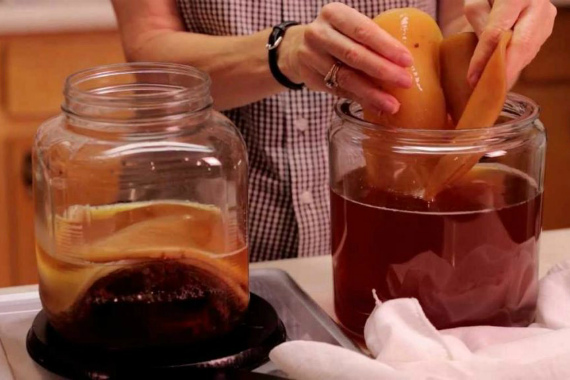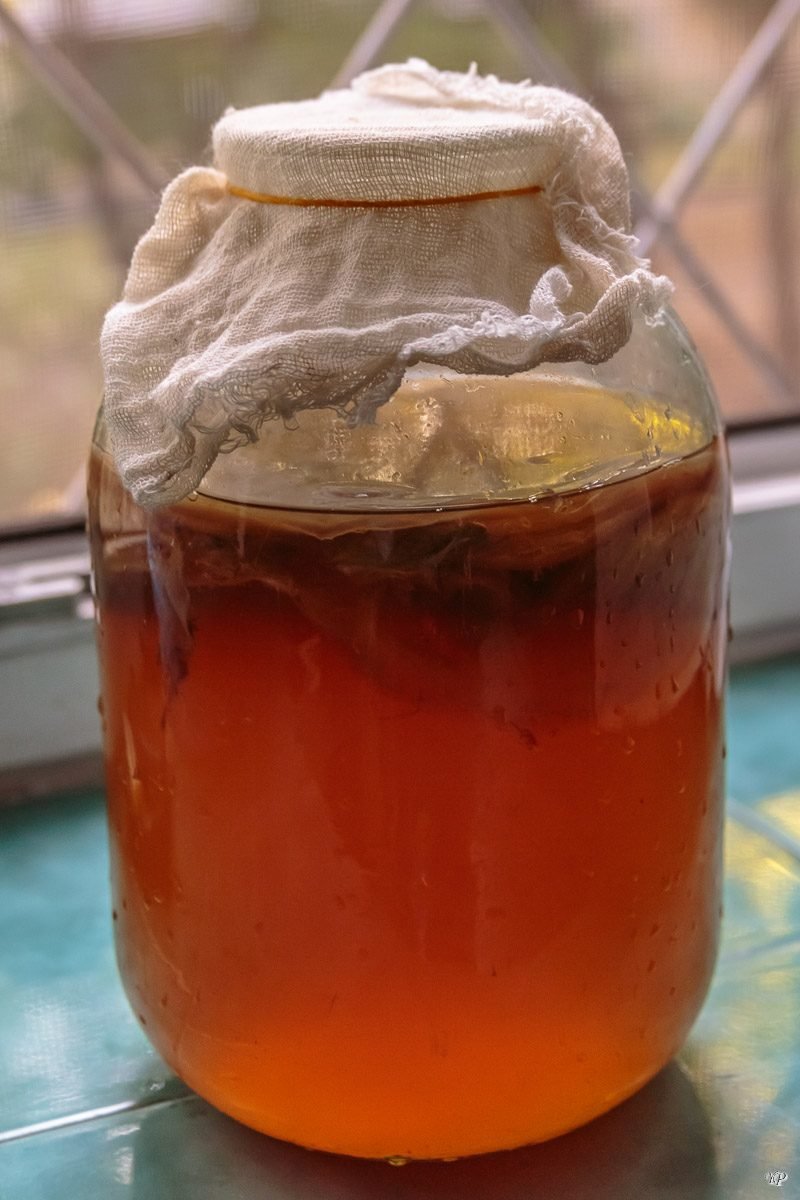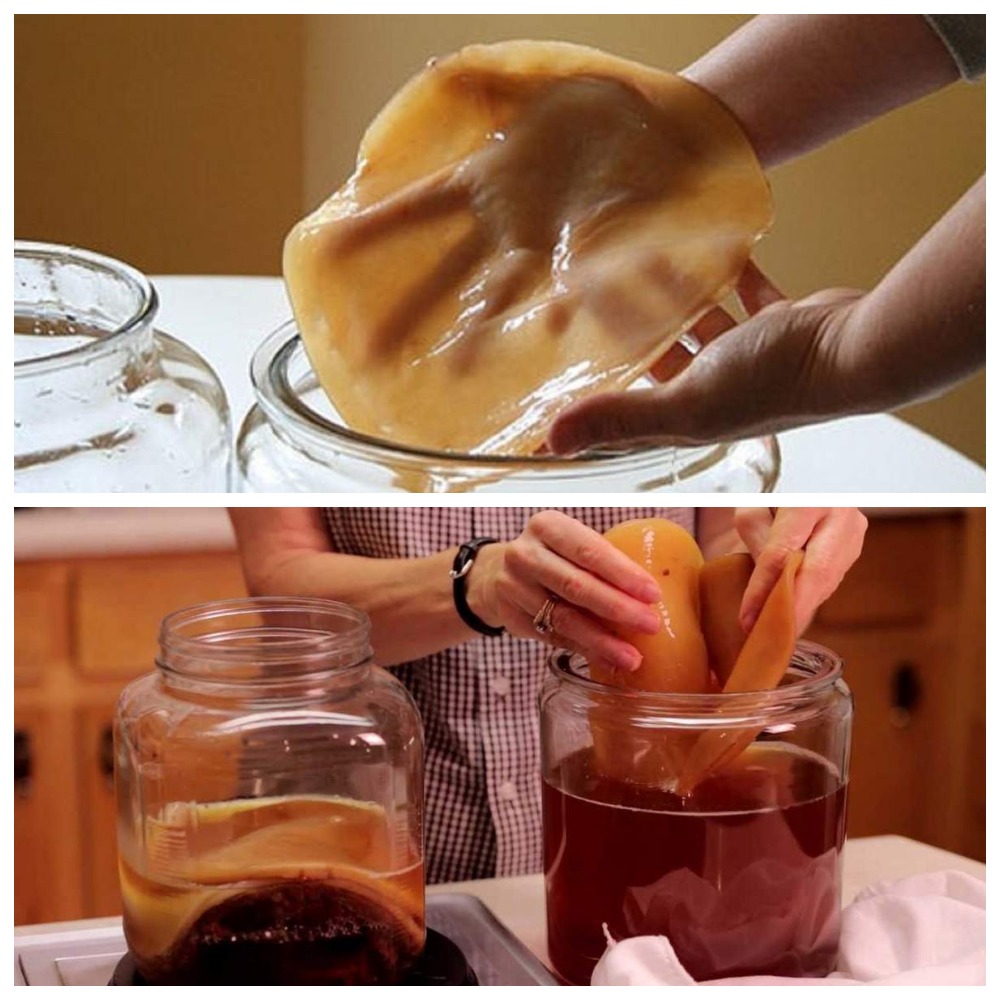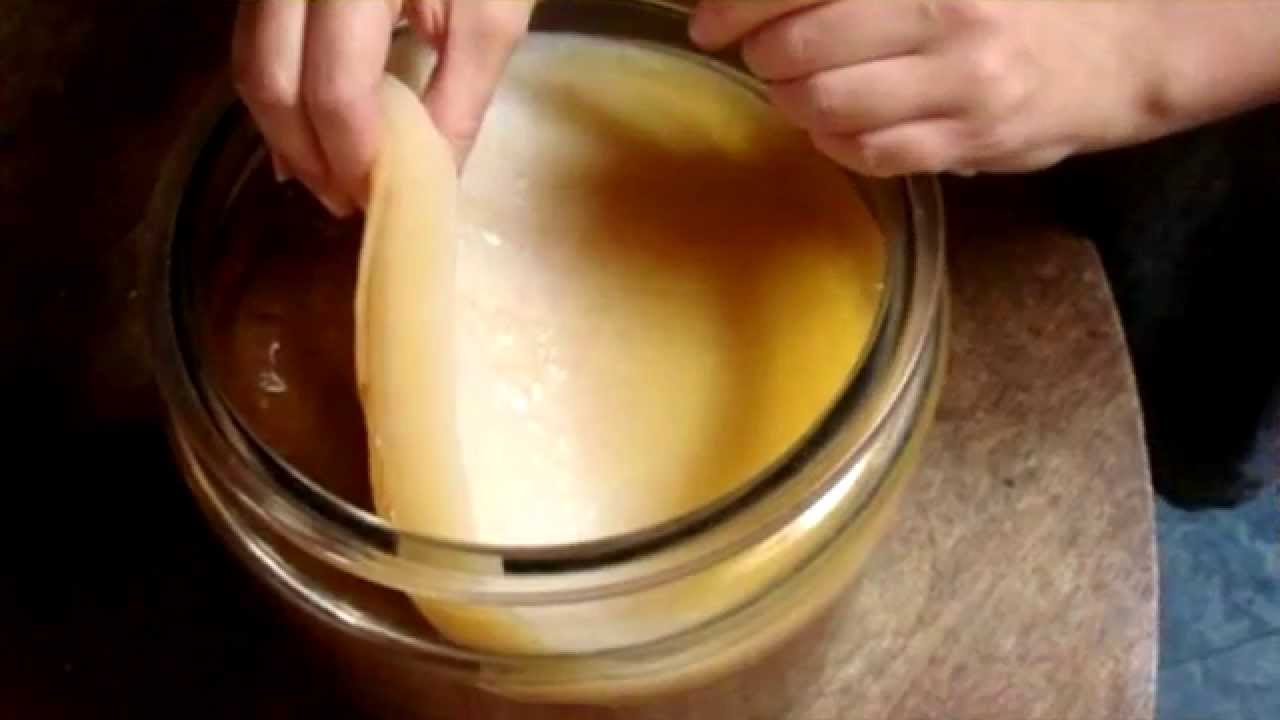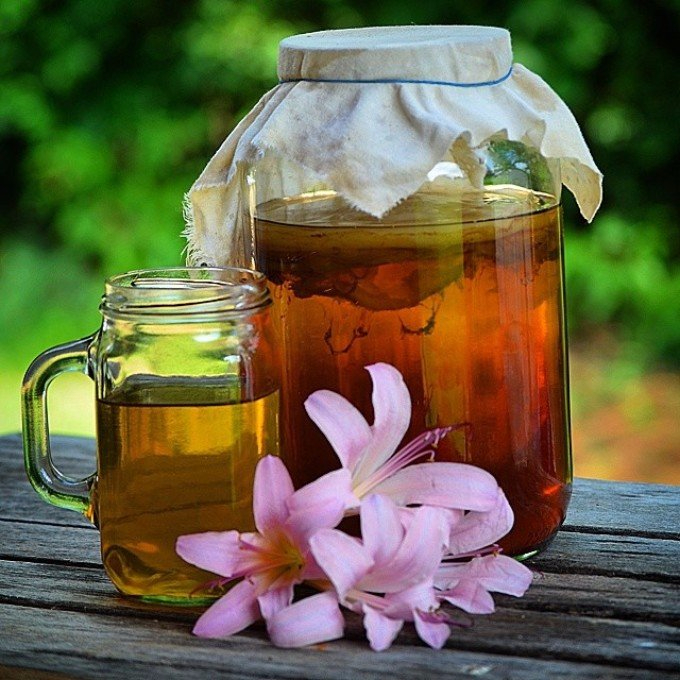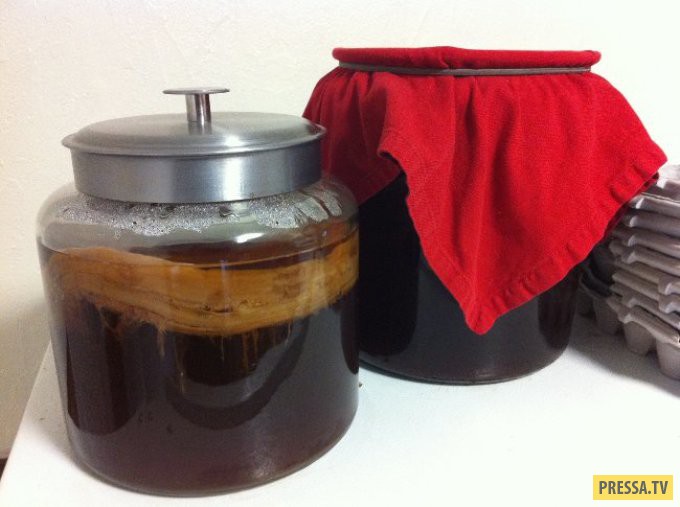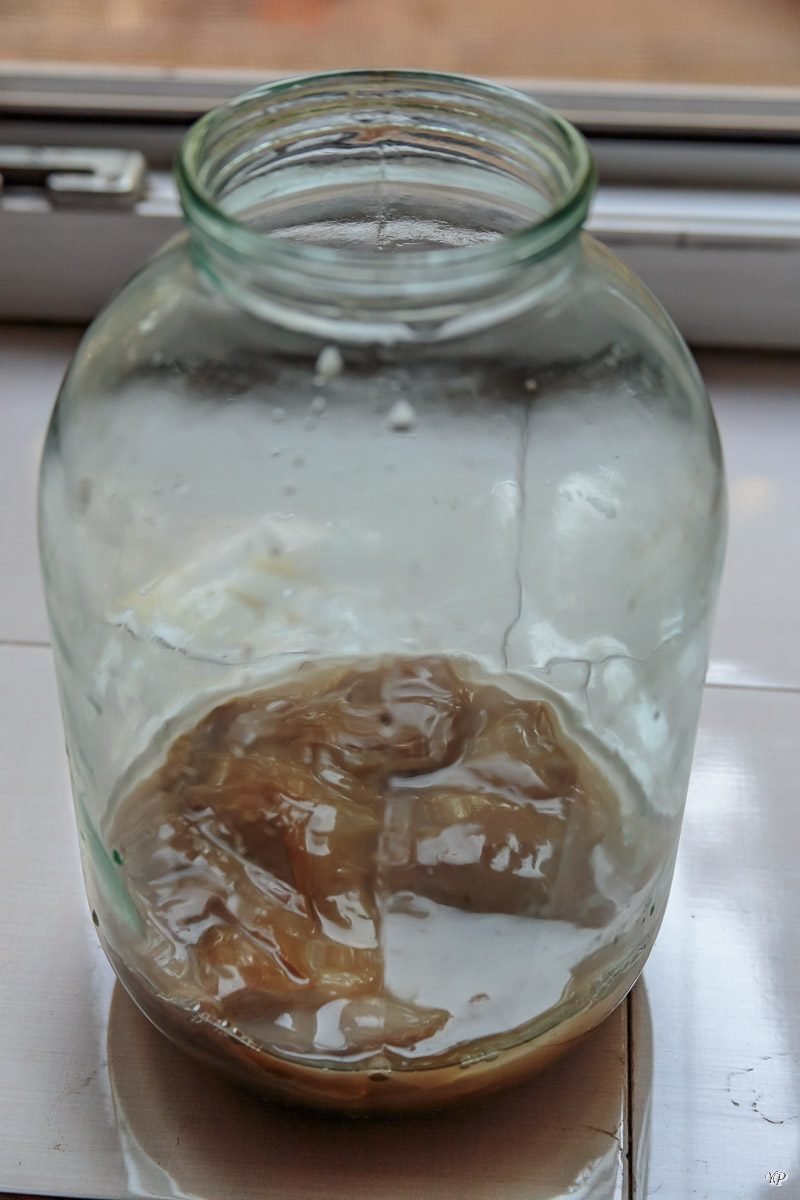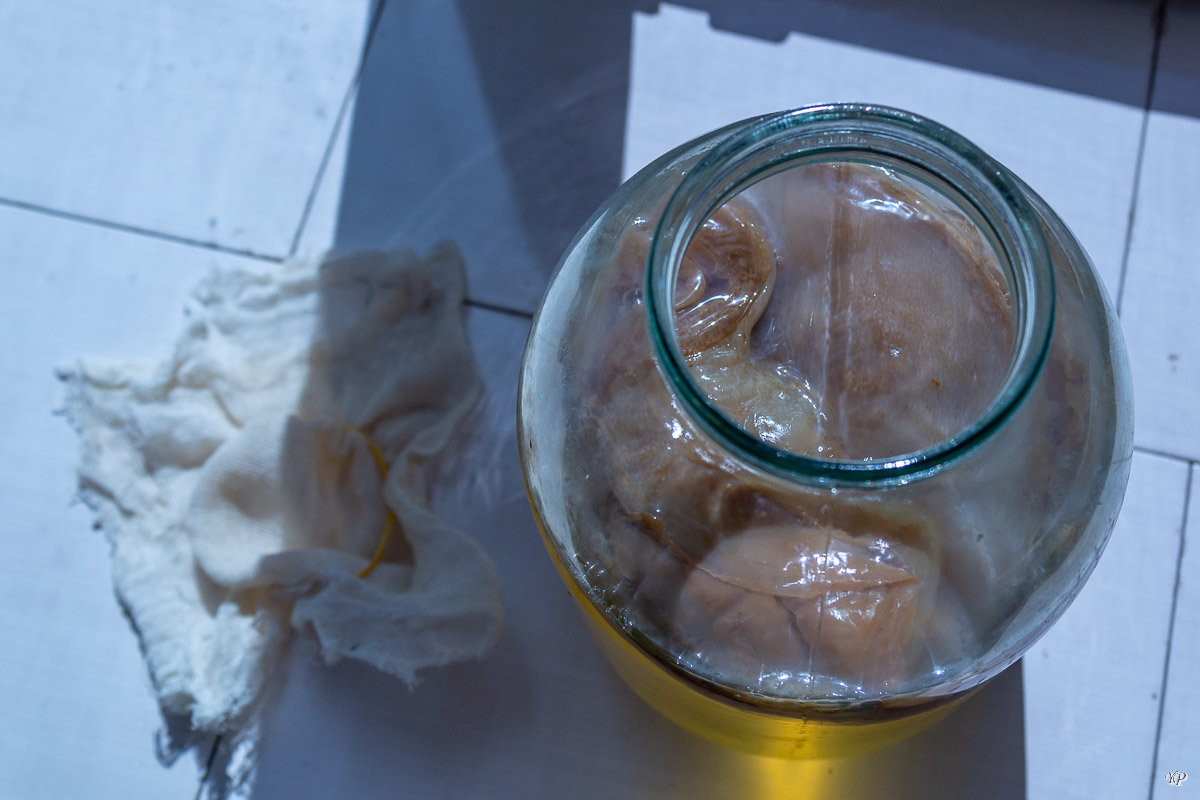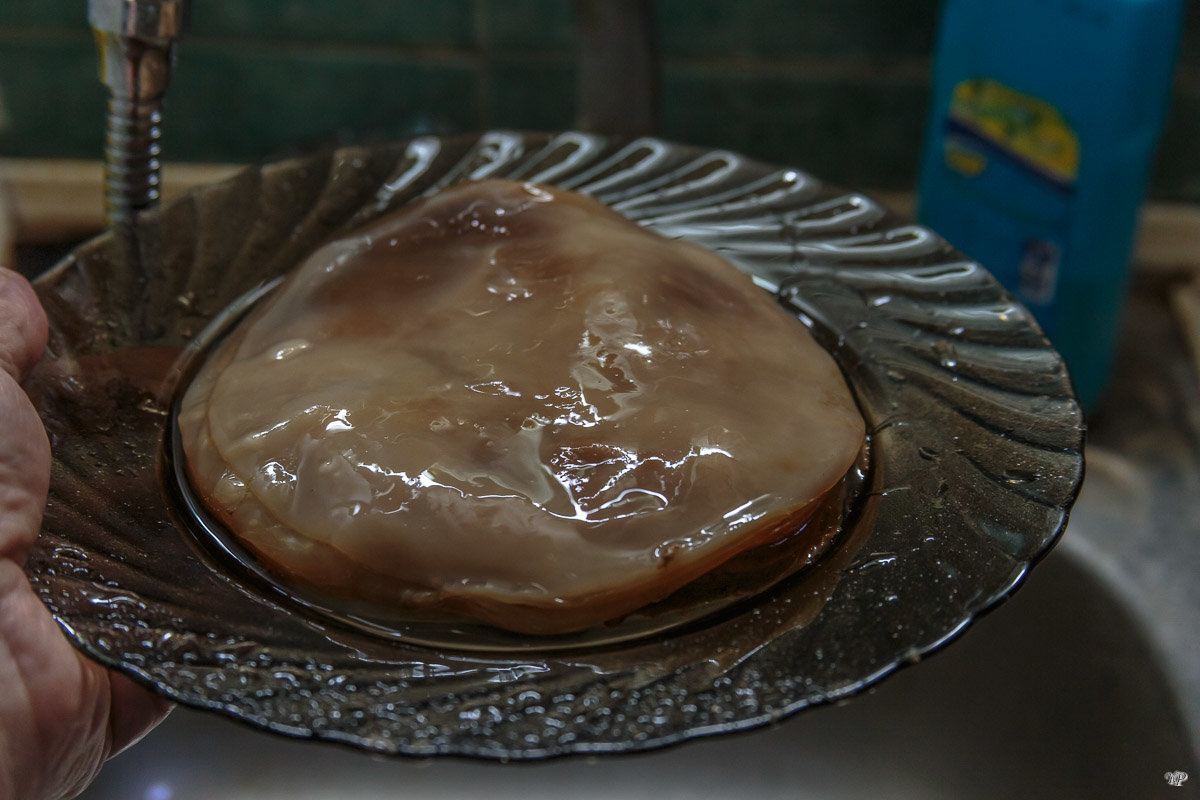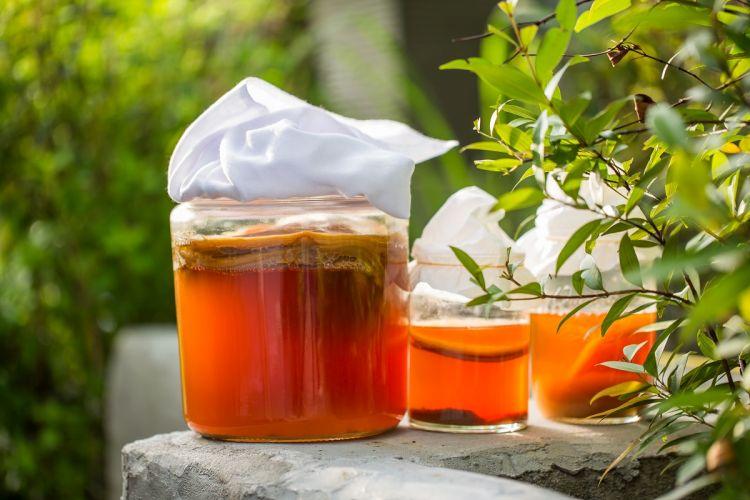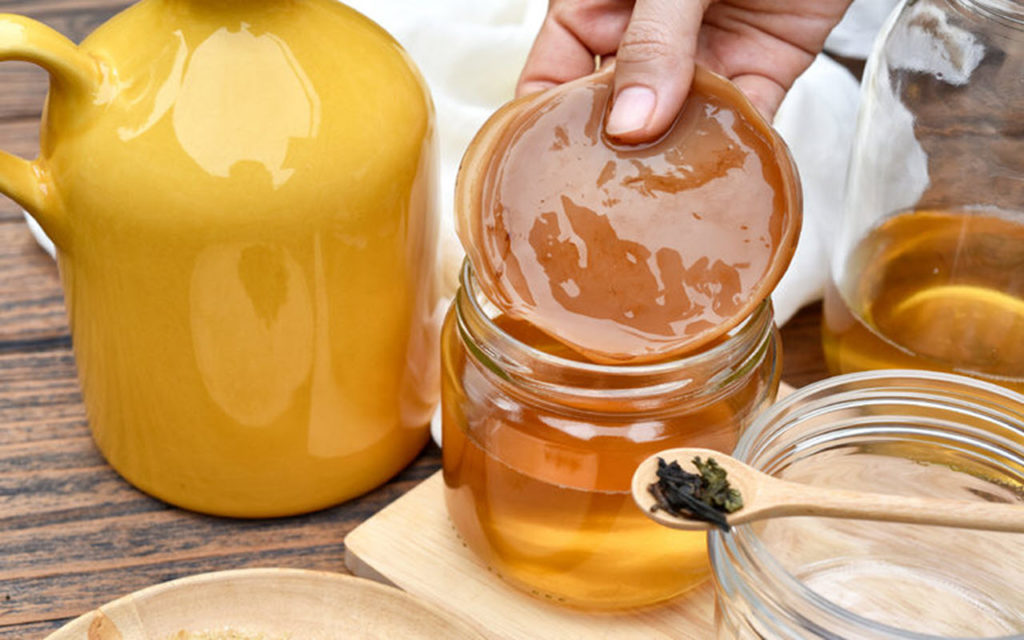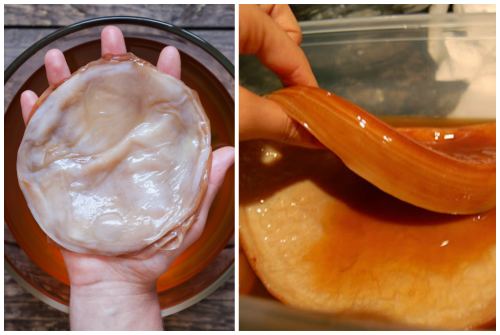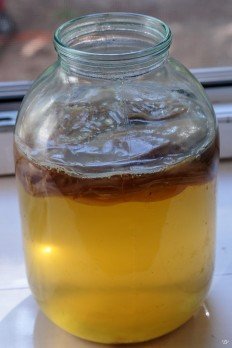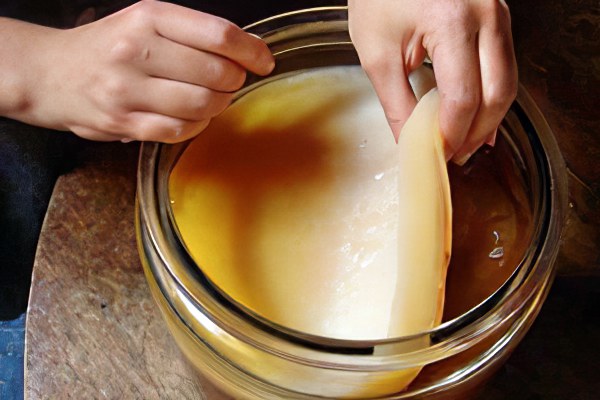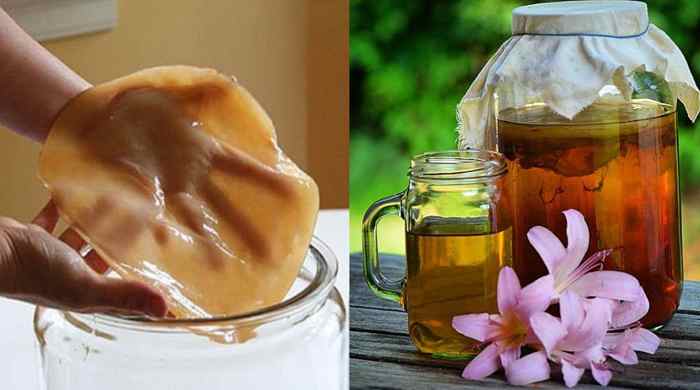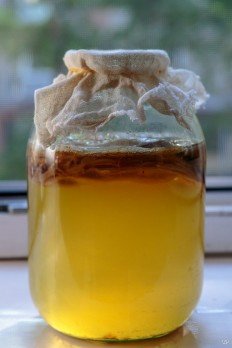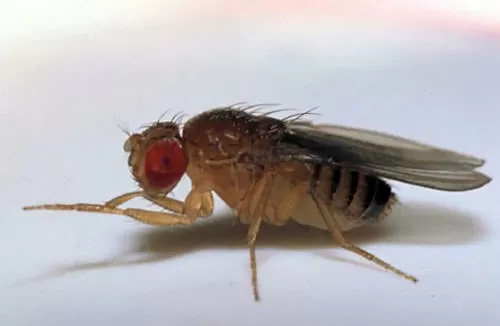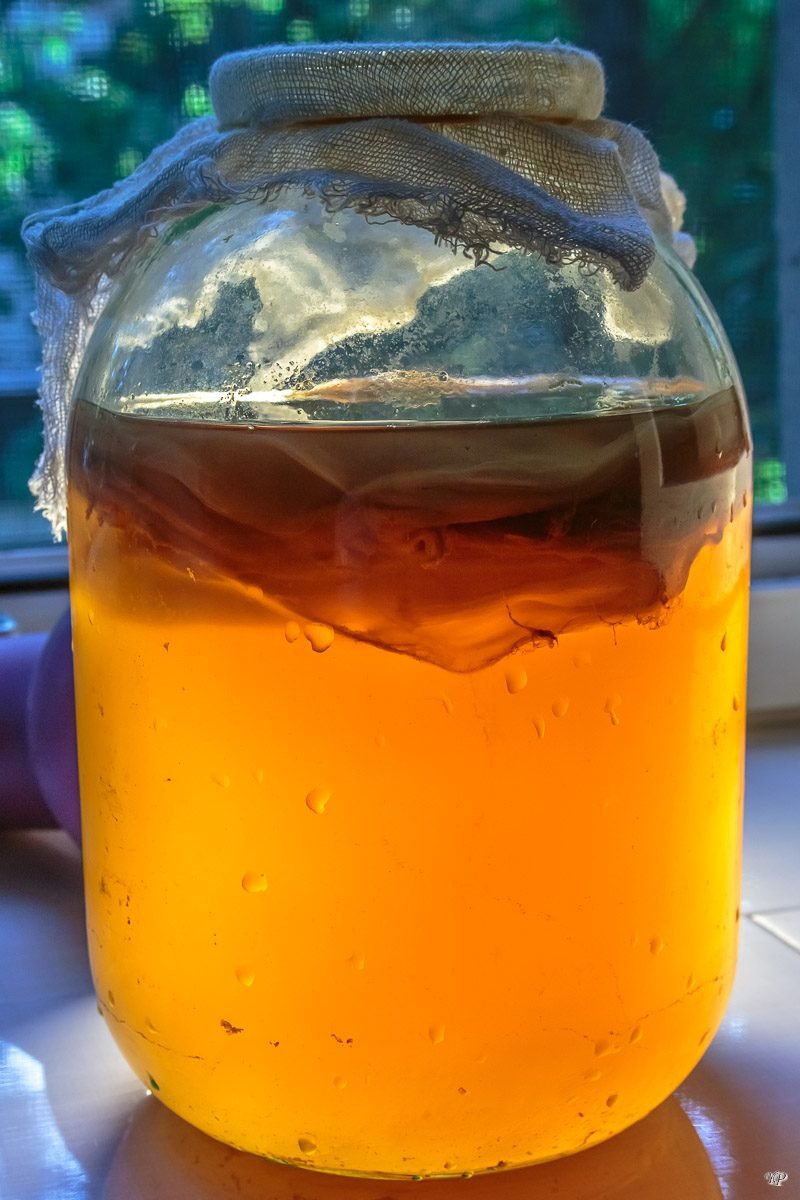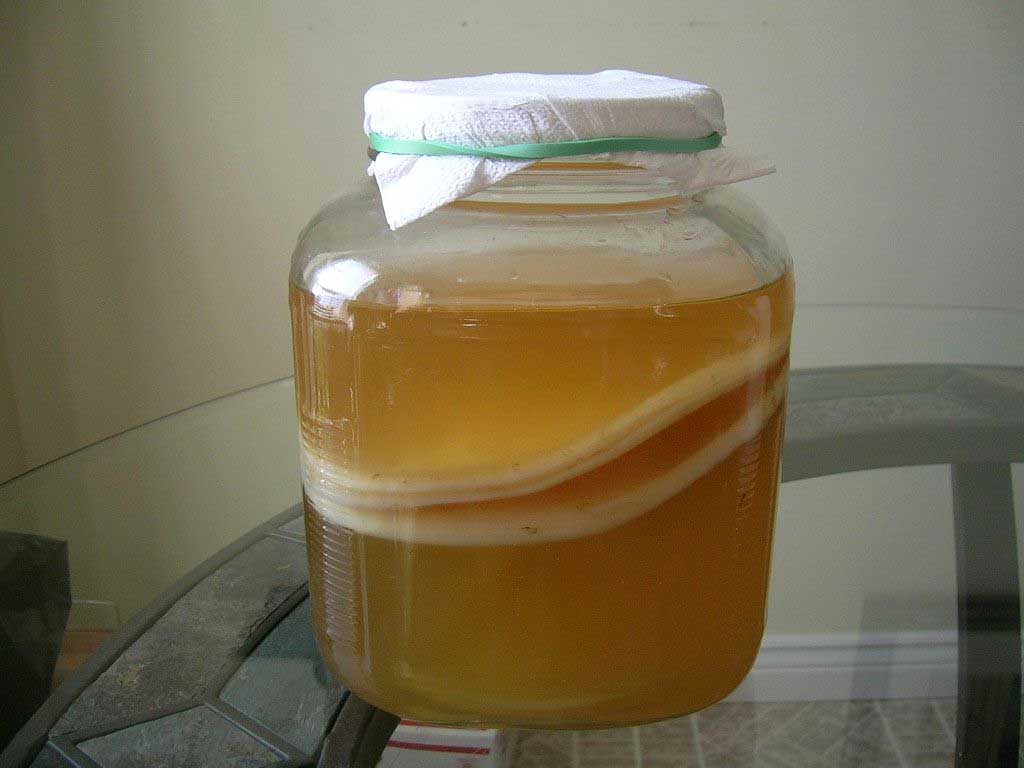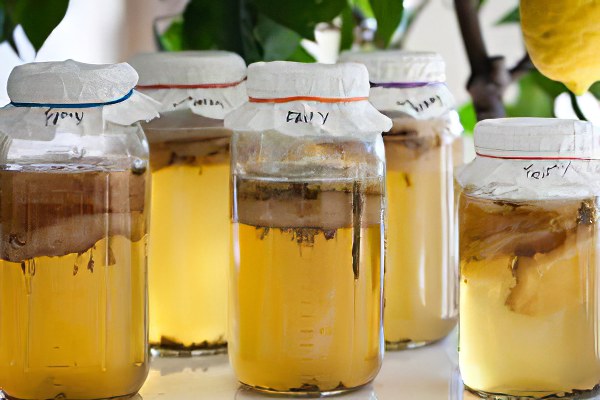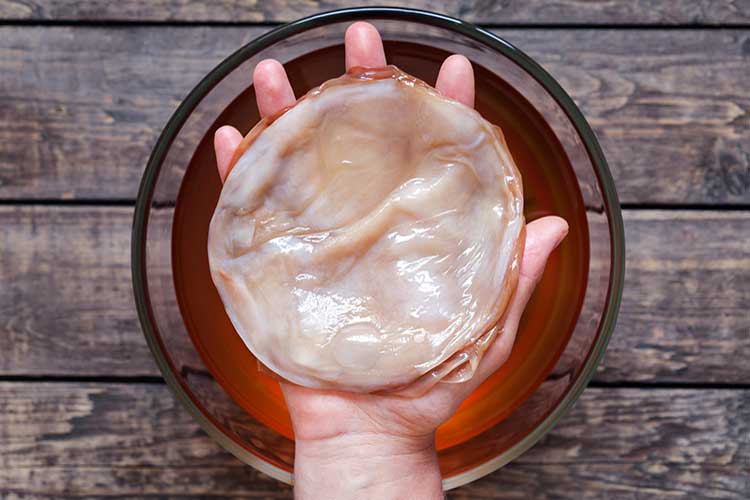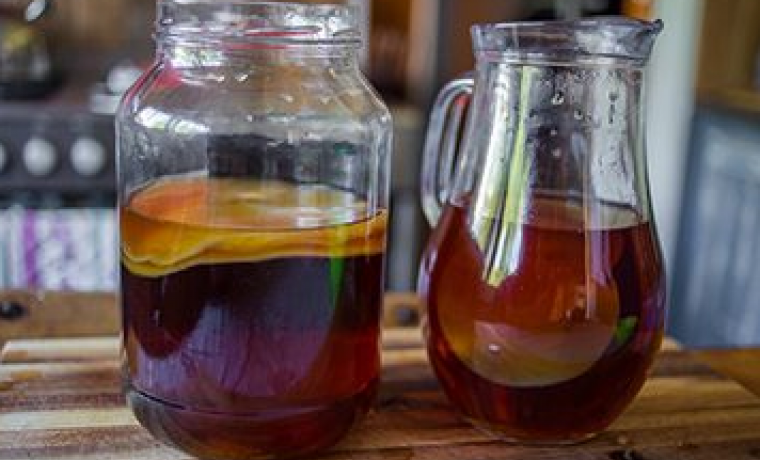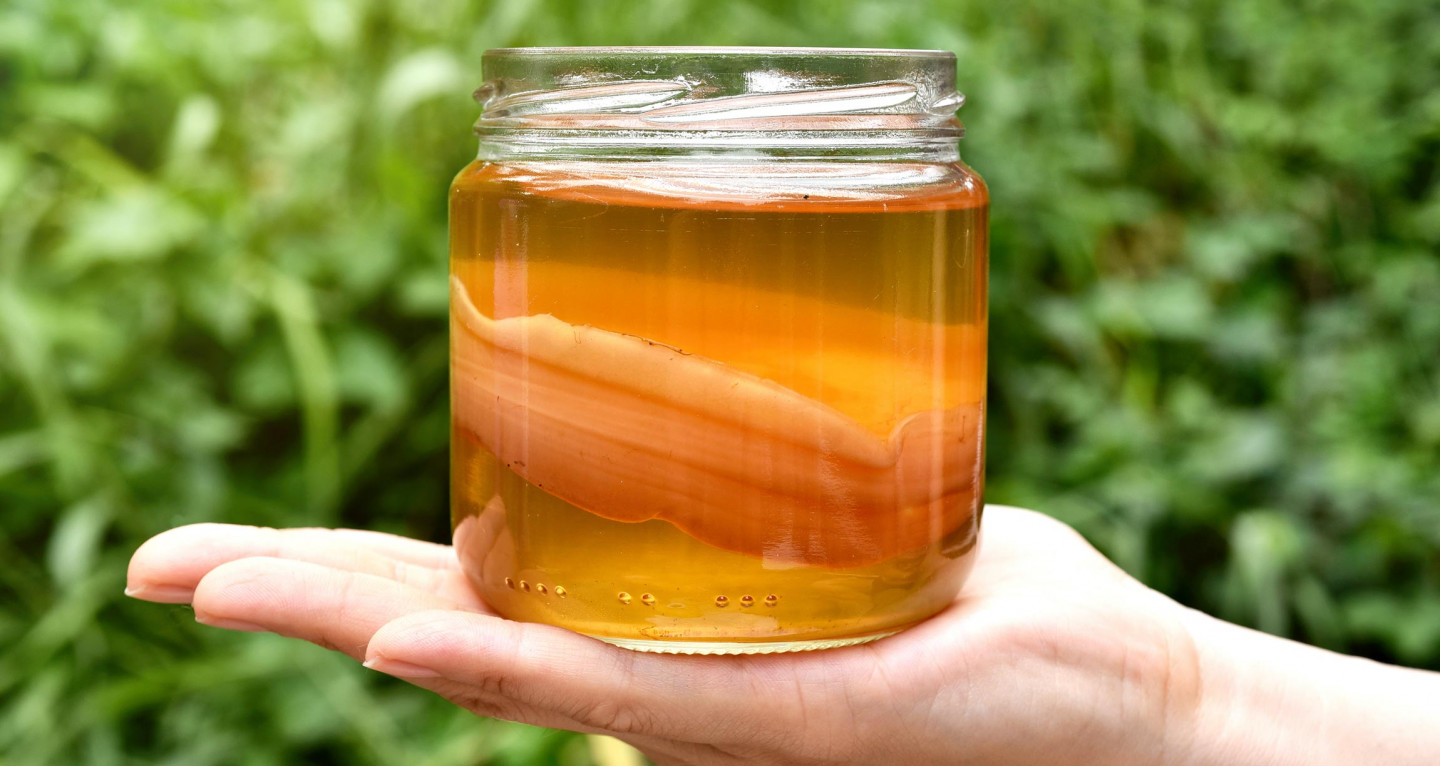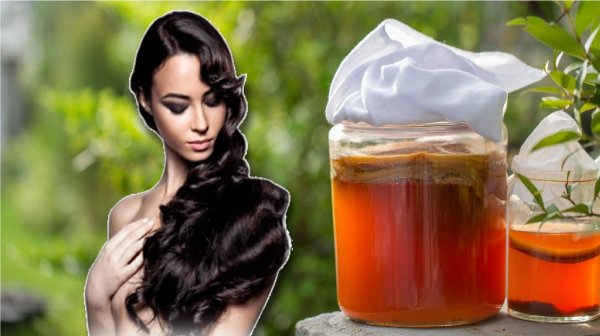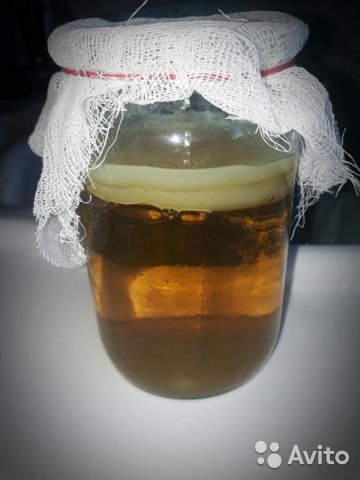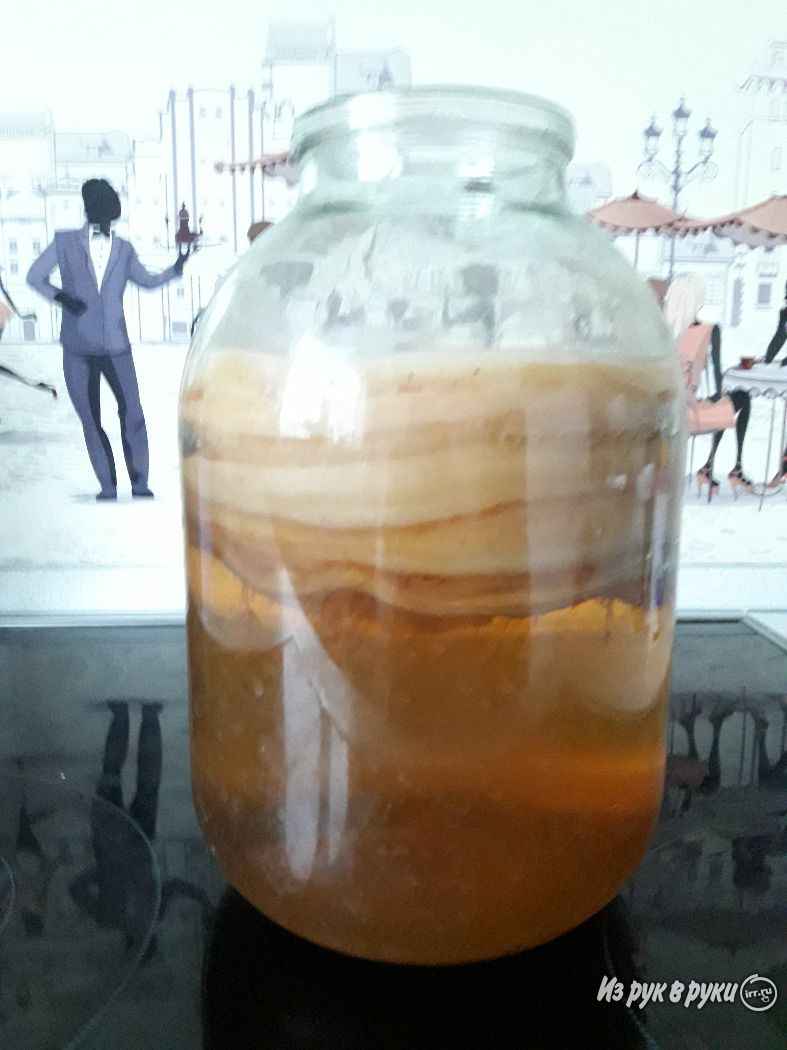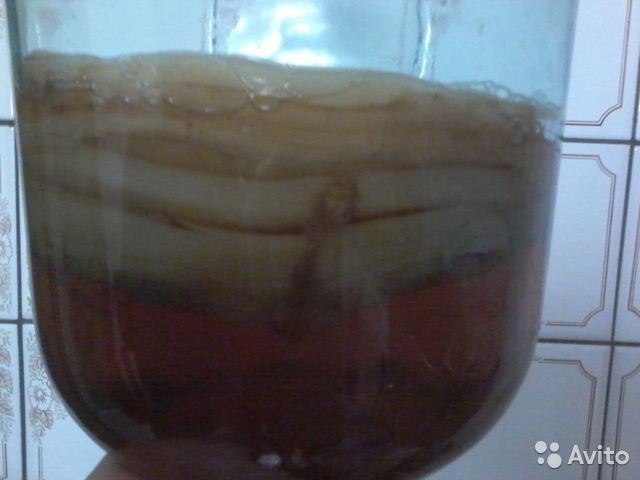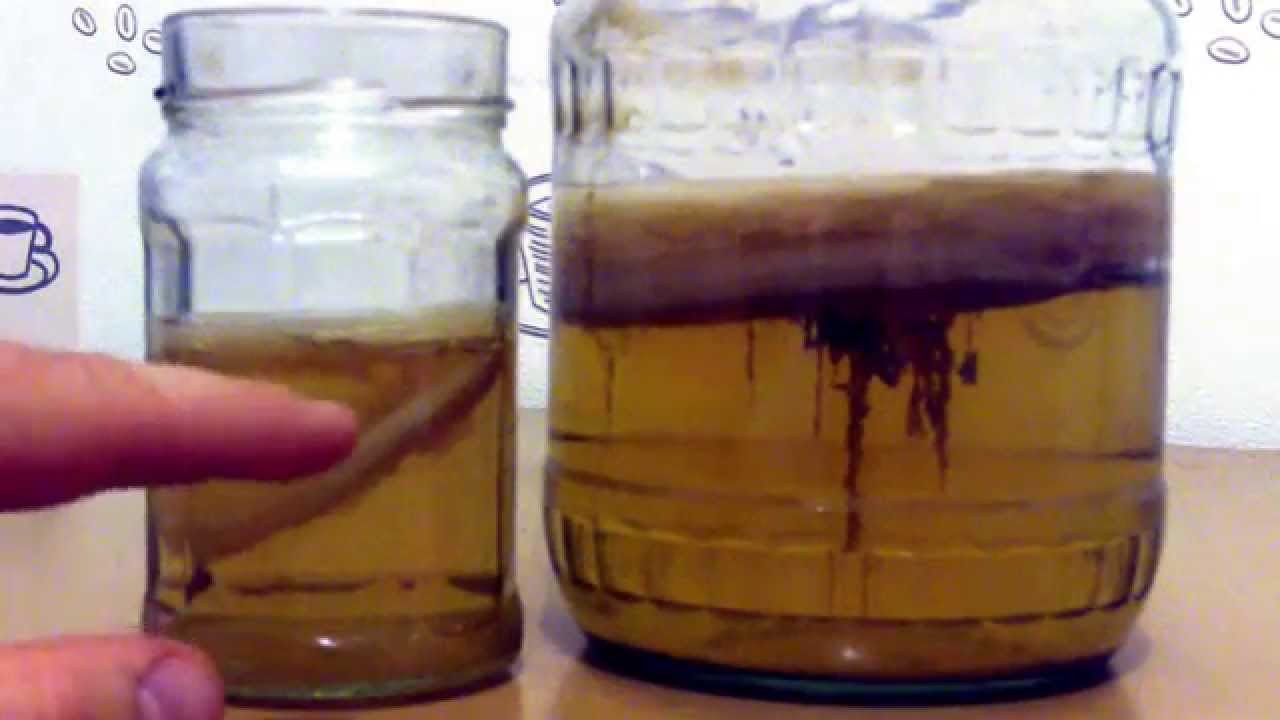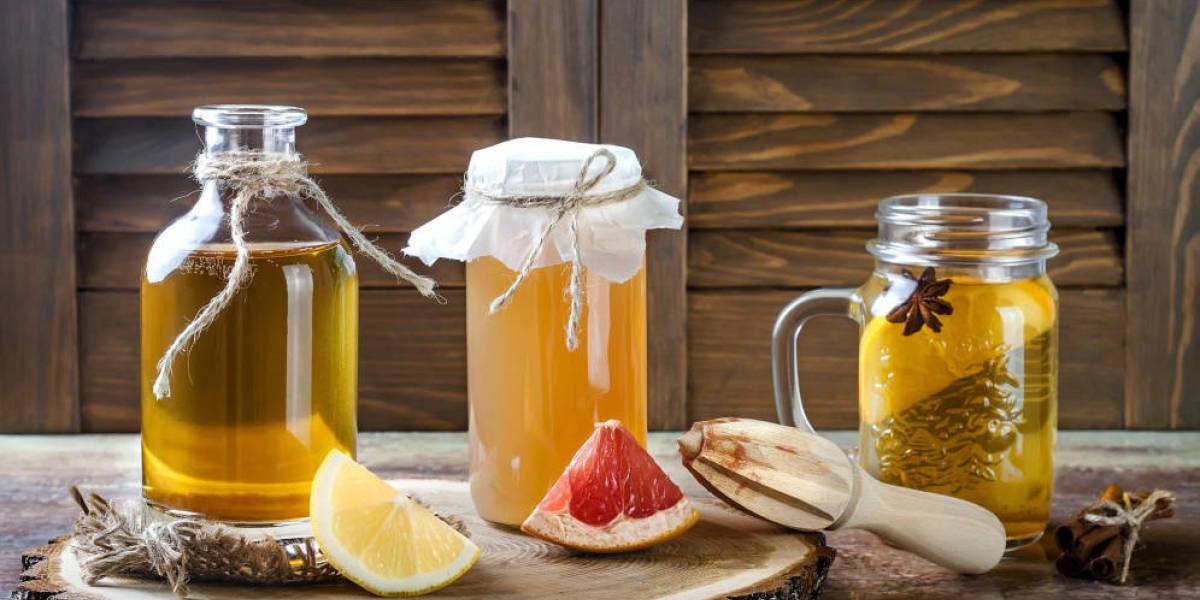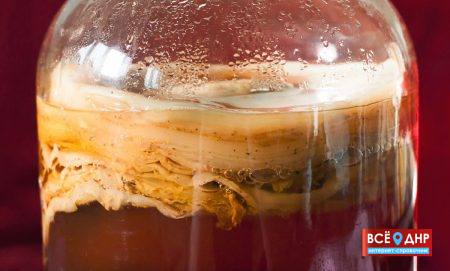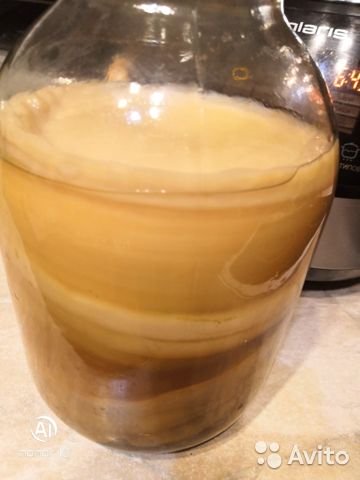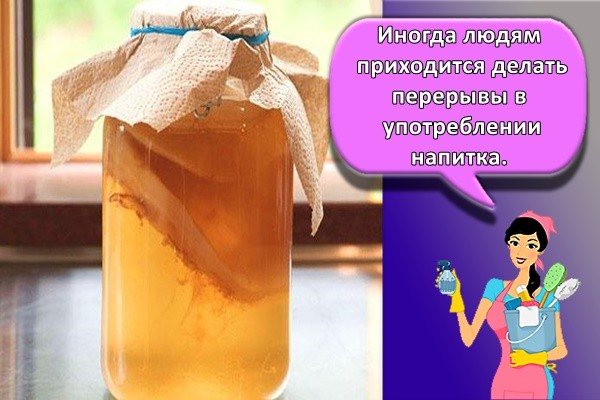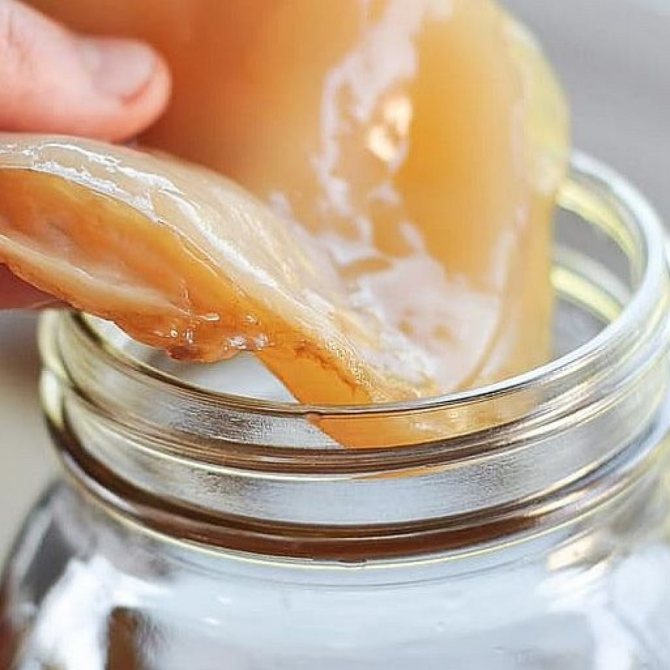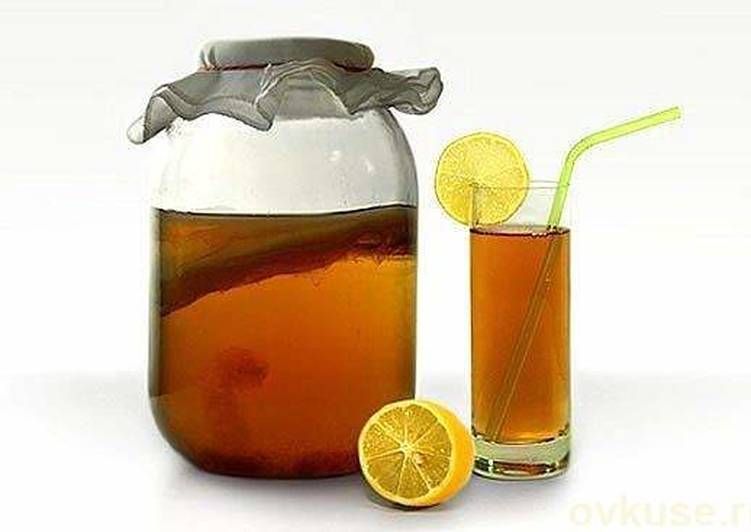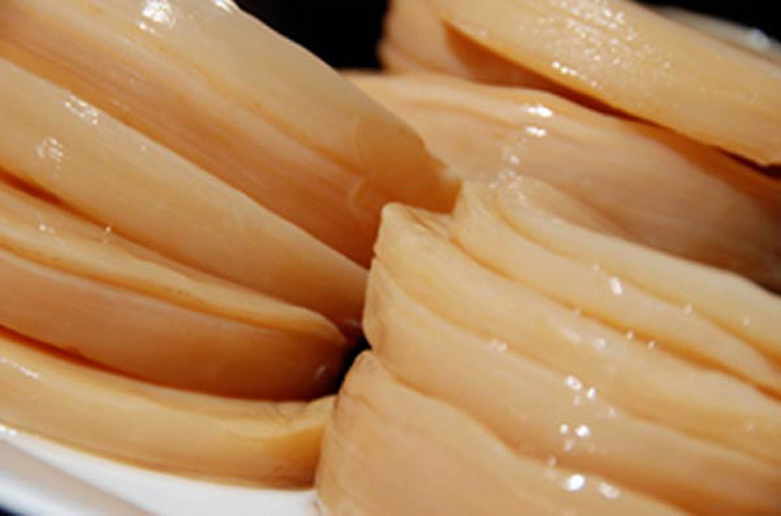Composition and calorie content of kombucha
The composition includes many useful substances and components. First, these are natural organic acids: acetic, malic, citric, oxalic, grape and lactic.
Further, digestive enzymes, amylase and lipase, tannins - tannins, monosaccharides, caffeine. Many vitamins: B, PP, D, C.
Another substance mentioned earlier is jellyfish, which is a natural antibiotic.
As for the content of proteins, fats and carbohydrates - most of all, the mushroom contains carbohydrates - they are in a mass ratio of about 8 g. In second place are proteins, there are about 3 g. As for fats, there are practically none.
In terms of calorie content, 100 g of the drink accounts for about 7 kilocalories. As a result, such a low calorie content makes it possible to use the drink not only for quenching thirst in the heat, but also for medicinal purposes.
Classically, kombucha is infused with black tea. However, many people use green tea. At the same time, the beneficial properties do not get worse.
Kombucha care rules
- the culture should be in a dark and warm place;
- it is strictly forbidden to close the jar with a lid, jellyfish (the scientific name for kombucha) must receive air;
- it is forbidden to pour hot tea into the jar, because it can burst or you will scald the creature in it;
- try not to allow grains of sugar and tea leaves to fall on the culture;
- before preparing a new infusion, be sure to rinse the mushroom;
- rinse it with warm boiled water, or even better with warm filtered water;
- it is advisable to feed the kombucha at least twice a week.
The most important thing is to periodically rinse it. It is important to remove all jewelry from your hands before rinsing it. This rule is required in order not to damage the culture and spoil the drink.
How often to change tea
In winter, the sweet solution of kombucha must be changed once a week, in summer - twice a week. The infusion can be filtered through a bandage folded in several layers or gauze, then poured back into the bottle, where the washed mushroom is placed.
In the event that the culture is not washed with water, it will become covered with dark spots and begin to deteriorate, and such an infusion can become hazardous to health, or even poisonous. Healthy "tea kvass" has a transparent color.
Growing, the mushroom grows in thickness, in order to divide it, you do not need a knife, it separates perfectly on its own. It is recommended to separate new layers from it and move them into the bottle, and leave the lower layers, because they are considered the most useful.
Proper care of kombucha
Proper care of kombucha and timely care it will allow the latter to live for many years, which will provide your family with a healing drink.
It should be remembered that the medusomycete has its own personal self-defense and, finding itself in not very good conditions, it falls into a "sleep", thus saving its life. Which means that if you take care of him badly and regularly change his tea, the tea gib will simply fall asleep and will not give you a healthy drink.
An important point is also to maintain cleanliness around the place where the culture will be located. The fact is that sweet tea infusion serves as a good environment for any bacteria and fungi. Therefore, hygiene rules must be observed when working with a mushroom, so you will protect the drink from harmful microbes.
For washing, it is advisable to use rubber gloves or wash your hands thoroughly with soap.
At the time of preparation of a new sweet solution, mix it with several glasses of the old infusion - this will allow the mushroom to develop faster and prevent unnecessary bacteria from entering the drink.
What else can you pour in kombucha
To make tea kvass, it is not necessary to use black or green tea, for example, to reveal certain healing qualities, you can use rosehip infusion or herbal mixtures.
If you give preference to liver tea, then the infusion will have a beneficial effect on the nerves, intestines and stomach. In the case of choosing herbal mixtures, two teaspoons of the collection are enough for one liter of water.
The best option for pouring kombucha is a combination of herbal tea with green or black tea, so you create the best conditions for the development of the mushroom and get a vitamin drink. However, herbs that contain essential oils are best avoided, otherwise, it will negatively affect your health.
What is harmful to kombucha
- nicotine smoke, it kills him;
- interaction with metal, therefore it is necessary to remove any jewelry from your hands. You can use only wooden, glass, plastic or ceramic dishes;
- unstable temperature indicators also harm him, he prefers heat, but not heat;
- dust, it can provoke its infection, the container must be covered with gauze fixed with an elastic band;
- insects, they like useful kombucha, but it must be protected from them;
- do not make tea based on essential oils, which may be present in some herbs.
Where to put unnecessary
Focusing on these rules, you can easily take care of the kombucha and keep it growing at home without any problems, then it will delight you and your family with its divine taste and unsurpassed benefits, which is what I wish you. Read a separate article about the beneficial properties, as well as how to grow it yourself.
Pros of Kombucha Treatment
When taken orally, Kombucha acts on all body systems, improving immunity, saturating organs and tissues with useful substances and vitamins. There are many advantages of treating nail fungus with a unique in nature kombucha:
- A cheap cure - only a little tea and sugar are needed for the development of kombucha.
- Completely eco-friendly and natural way of treatment.
- Mild effect on the body.
- Few side effects.
- Suitable for everyone.
- Has a pleasant taste and aroma.
However, kombucha also has disadvantages. If you take it more than 1 liter per day, diarrhea may begin - the mushroom has a weakly pronounced laxative effect. In addition, baths, compresses, and the use of a drink are, rather, an additional treatment, which will not be enough without the use of medications. Nail fungus will not go away if you only use the fermented beverage.
How to treat acne on the nose
About how to get rid of comedones, dermatologists usually give one answer. Namely, a five-step treatment is needed, which will take into account the normalization of each stage of comedogenesis (the process of formation of acne), which, as already mentioned, is the direct cause of their appearance.
- Normalization of the process of keratosis and exfoliation. To reduce the adhesion of keratinocytes, drugs containing retinoids are usually used.
- Limiting the number of bacteria. The use of preparations containing benzoyl peroxide, azelaic acid or sulfur is recommended. Antibiotics are also prescribed, such as erythromycin, light therapy.
- Elimination of blockage of the mouth of the pores. Preparations that help soften keratinocytes containing ANA or BHA are recommended.
- Elimination of inflammation. In addition, dermatologists sometimes prescribe steroid treatment.
- Reducing the amount of sebum produced. This is the final step in the treatment program. Antibiotics, retinoids may be prescribed. Daily care with products containing citric, salicylic or azelaic acid is important.
Kombucha and insects
|
“Fruit flies are a family of the order Diptera, which includes more than 2000 species.Has worldwide distribution. The most famous genus is Drosophila. The life cycle is 10-30 days. "
|
Another problem that owners of kombuchas may face is insects (most often during the warm season). Ants, mosquitoes, flies - they can all end up in a jar of kombucha. And if ants and mosquitoes can turn out to be "accidental guests", then flies (especially fruit flies), purposefully seek to penetrate the jar. They are attracted to substances that are produced during the fermentation of sugar by yeast. If the flies have access to the jar, they lay eggs (about 0.5 mm in length) on the surface of the mushroom. After a day, larvae emerge from the eggs, which intensively feed on the waste products of the kombucha. After 4-5 days, the larvae crawl out onto the walls of the jar - the pupation stage begins. They become immobile, significantly decrease in length and acquire a barrel-shaped shape. In about another five days, adults emerge from the pupae. To eliminate the troubles associated with insects, you need to take care of blocking their access to the jar with the mushroom. - The neck of the container should be covered with a napkin or breathable cloth and covered with an elastic band from below. - to exclude the presence of sources of fermentation and decomposition in the room with the fungus. - use insect traps. The simplest gnat traps Glass jar 1. Place the bait (pieces of fruit or some kombucha) in a glass jar. 2. Roll a funnel out of paper. 3. Cut off the tip of the funnel. 4. Insert the funnel into the jar, tip down. Glue the junction with tape. Plastic cup 1. Place the bait for midges in a plastic cup. 2. Pull cling film on top of the glass. 3. Make small holes in the film (the size of the hole should be such that the midge could crawl through). 4. We put the glass next to the kombucha. |
Kombucha face masks
For aging skin, you can prepare a special mask to nourish and restore it. To do this, you need to take 3 full spoons of the infusion of a month's exposure, add a spoonful of fresh carrot juice, half a spoonful of natural olive oil and the beaten yolk of one raw egg to it. After thorough kneading, the mass must be spread over the face in an even layer using a cosmetic brush and washed off after 10 minutes with clean water.
For oily skin, it is recommended to mix the infusion of the substance with natural aloe juice. The combination of liquids occurs in a 2: 1 ratio, that is, for 2 tablespoons of kombucha infusion, you need to take a spoonful of freshly squeezed aloe juice. The resulting product should be wiped off the skin of the face 2 - 3 times a day, as a result of which the surface of the face is dried, the oily sheen and greasy deposits are eliminated, the intensity of the inflammatory process is reduced and the symptoms of irritation are eliminated. Gradually, the skin becomes healthier and acne disappears from its surface.
For oily dermis, you can prepare another mask by mixing 40 grams of cosmetic clay (blue or white) and infusion of kombucha so that the consistency of porridge is obtained. Add to the mass a spoonful of mineral water, 5 - 7 drops of freshly squeezed lemon juice, as well as freshly grated lemon zest on a fine grater (one spoon). This mask should be washed off after 15 minutes.
For oily skin characterized by excessive sweating, you can prepare a special lotion by mixing half a glass of ready-made kombucha infusion with three slices of lemon, which need to be wrinkled a little. After half an hour, you need to remove the slices, carefully squeeze all the juice out of them, filter the liquid, pour 2 tablespoons of high-quality vodka into it. Use the product to treat the face twice a day.
Very useful in the care of oily skin, a mask prepared from infusion of kombucha, and fresh ripe strawberries.To prepare it, you need to take 5 large strawberries (best directly from the garden), wash them, dry them with a napkin, peel them off and mash them thoroughly in mashed potatoes. Add 3 - 5 tablespoons of mushroom infusion to the resulting mass, mix and leave for several hours. After settling the thick, the liquid must be carefully drained, and the remaining mass should be applied to the prepared skin of the face, leaving for 10 - 15 minutes. The drained liquid can be used to rub the skin or make ice cubes.
Kombucha from parasites
Treatment of severe parasitic infection is carried out at the suggestion of an experienced doctor, but when the disease is mild: mild lethargy, drowsiness and rash, few will go to the hospital. Since synthetic antihelminthic drugs have a large number of contraindications and side effects, and also not all are sold without a prescription, you have to resort to traditional medicine methods.
Healers suggest expelling parasites from the body with the help of garlic, cloves, wormwood, pumpkin seeds and pine nuts. However, the proposed decoctions and tinctures need to be taken for more than one month to get the expected result. Kombucha treatment is much more useful and effective. This is one of those universal folk remedies that has no contraindications and has a beneficial effect on the state of all body systems. In oriental medicine, it is proposed to drink a decoction of kombucha for gastritis, ulcers, hepatitis, pancreatitis, cholecystitis, etc.
Compared to other synthetic and herbal anthelmintics, Kombucha extract has many benefits:
- is a 100% natural cleansing medicine that does not contain allergens, so it can be given to children and people with any history;
- has no contraindications and does not cause side effects, so it can be taken without a doctor's prescription;
- the composition of the drug does not contain extracts with an aggressive choleretic effect, therefore, kombucha can be drunk regularly (with short interruptions), which will be the best prevention of not only parasitic, but also bacterial and viral infections;
- has a pleasant delicate taste and aroma, so even children will not refuse such a medicine;
- is a powerful detox agent that can cleanse the body of worms in just a month;
- has quality certificates and is one of the few traditional medicines recommended by official medicine.
Kombucha disease
If the kombucha is covered with a burgundy brown film, this means that your mushroom is dying. Try to carefully detach the damaged layer, change the solution and change the conditions of the mushroom for the better.
Brown spots on kombucha
Brown spots on the surface of the mushroom are probably burns from the touch of granulated sugar or tea leaves. Take your time to throw away the mushroom, first try to cure it. To do this, you need to remove the affected layer and stop pouring sugar on the surface of the mushroom or stir it more thoroughly, as well as filter the tea solution from the tea leaves. He will do the rest himself - kombucha is able to heal both you and himself.
If the kombucha is overgrown
The more layers a kombucha has, the stronger and healthier it is. But a very thick mushroom is more difficult to manage - it is not easy to take it out of the jar, rinse it properly, which in turn is fraught with unwanted guests in its body. So, if your mushroom has grown so thick that it has become difficult to crawl into the neck of the jar, it is better to remove one or two layers.
Kombucha mold
Mold can, although rarely, grow on the surface of the kombucha. Mold is formed primarily when open sources of mold appear in the environment or when spores become dusty.The most favorable chances for mold development arise when the kombucha is not in the right conditions to inhibit the yeast and kombucha bacteria. In particular, mold is especially active in smoky rooms and in rooms with unfavorable temperature conditions.
If it happens that the kombucha has become moldy, then you need to pour out the contents of the jar and rinse the mushroom thoroughly with running water. The vessel in which the kombucha will live and the mushroom itself should be rinsed with boiled vinegar. Re-add the tea and sugar solution and place the mushroom there. Reconsider the conditions for keeping Kombucha: dark place, temperature close to +25, cover the neck of the jar with thick gauze or a napkin, read the detailed article: "Care and storage of Kombucha."
Also, moldy and brownish particles can form on the surface of the kombucha - these are extinct cells
If such symptoms appear, the mushroom should also be rinsed with cold or lukewarm water and carefully scrape off the particles with a teaspoon.
If the mushroom begins to turn white or small islands appear on the surface of the liquid, this is not mold, but newly sprouted mushroom skins, as well as small bubbles of carbon dioxide formed during fermentation. Don't worry - your mushroom is fine.
Blue-green algae in a jar with kombucha
By themselves, blue-green algae are completely harmless to humans, and some of their varieties are even eaten. But if you notice that they appear in the kombucha jar, that should alert you. For kombucha, their proximity is completely undesirable, and if they appear in the jar, then the temperature of the culture is too low, which suppresses its activity and the fermentation process stops. If you change the tea solution, rinse the mushroom and change the conditions of its keeping to more comfortable ones, the mushroom will start working again.
Midges, worms, larvae in the body of kombucha
Drosophila flies, which appear in liquids containing sugar and alcohol, as well as fruits, can create a big problem for owners of kombucha. The sense of smell of these noxious midges is extremely developed. Drosophila appear out of nowhere, buzz around a vessel with a kombucha, sit on the gauze covering its neck and strive to get inside. Therefore, carefully make sure that the neck of the can is always covered with a sufficiently thick gauze, a scarf or napkin, tightly pulled with a braid or elastic band. If the midges still manage to get to the mushroom, small worms soon appear on its surface. And, although, in fact, these are just the larvae of future fruit flies and they are not the cause of any special troubles, it is unlikely that after the discovery of worms in the mushroom, someone would think to continue using it.
On the outer walls of the container with Kombucha, you can fix duct tape or hang special scotch tape for catching flies. You can arrange bottles with narrow necks, half filled with beer or wine. Such a bottle-trap in the summer can be a real salvation.
Proper care, storage, and how the mushroom multiplies and how to grow a new mushroom from its own infusion, read the article: "Care and storage"
Instructions for making kombucha drink
- First of all, it is necessary to determine the capacity in which the mushroom will be located. Usually a 3-liter jar is used at home. If possible, it is advisable to take the jar with a wide neck (do not use metal utensils for preparing and storing the drink).
- We prepare not very strong sweet tea (about 5 tablespoons of sugar and 2 teaspoons of black or green tea infusions per 1 liter of water), pleasant to the taste. It is recommended to brew tea for at least 15 minutes.
- We are filtering tea.The sugar should be completely dissolved, and there should be no particles of tea leaves.
- Let the tea cool to room temperature. The culture will die if placed in a hot solution.
- For young mushrooms: a little infusion of the mushroom from the jar where it was previously kept as a "starter culture" should be added to the tea (the amount of infusion should be about 1/10 of the total volume of liquid).
- We place the mushroom in the jar. We close the neck of the dishes with gauze or a paper napkin and fix it with a braid or elastic band, so that the kombucha can breathe, but so that small midges and dust cannot enter the jar. We put the jar in a dark, warm place - the ideal temperature for a vat mushroom is about 25 ° C.
- After 4-10 days of infusion, Kombucha is ready for use. The fermentation time depends on the air temperature in the room - the higher the temperature, the faster the drink will be ready.
- When the drink reaches the acidity you want, remove the kombucha with clean hands, rinse it under cold running water and put it in a jar of cold sweet tea prepared in advance according to the same scheme.
- Pour the finished drink into a glass container with a tight lid, filling it to the brim. To get the maximum pleasure from the drink, let it ripen for several more days in a cool place (at least 5 days) - bacteria stop functioning without access to air, and the yeast continues to work if the container is tightly closed, the gas resulting from the activity of the yeast will not be able to escape and you will have a delicious fizzy drink. Strain the drink through cheesecloth or a plastic (not metal) strainer before drinking.
A mushroom at a venerable age reaches a thickness of several centimeters (its area depends on the area of the container in which it lives) and allows you to drink the infusion every day directly from the jar where the mushroom is contained (of course, you must remember to replenish the infusion with a new portion of cold, sweet tea).
It is convenient to have two identical cans in stock: in one, the kombucha will live, and in the other you will pour the finished drink. In the refrigerator, hermetically sealed glass containers with the infusion of the chanterelle mushroom can be stored for quite a long time, retaining their healing and taste properties.


